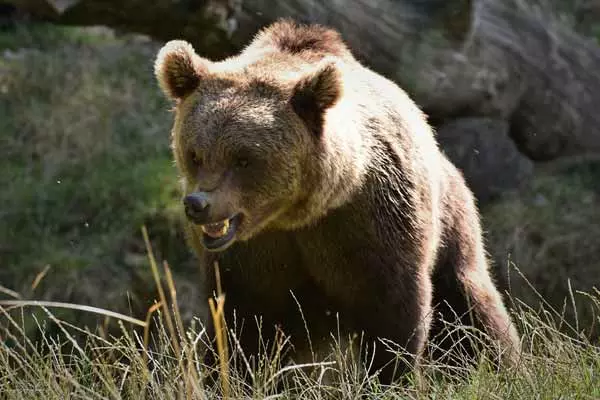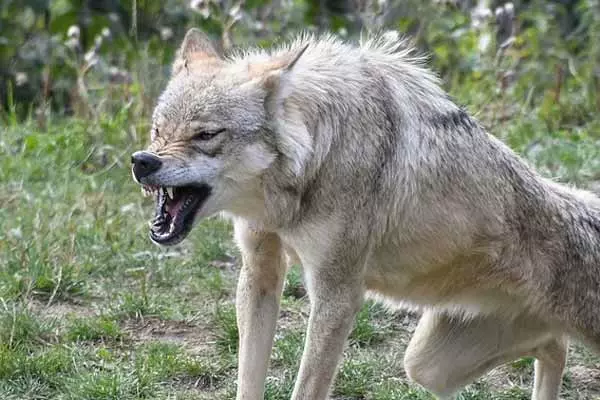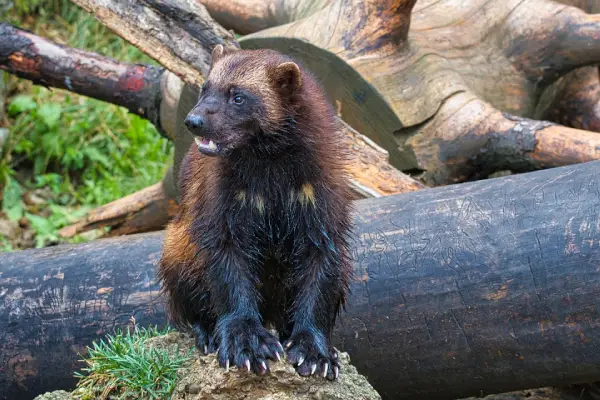Looking like a combination of a bear and a wolf, wolverines are probably one of the least-known land predators.
They are one of the most aggressive animals with immense strength, courage, determination, and skill – wolverines are known to hold their ground against bears, wolves, bison, lynxes, and elk.
They are the largest terrestrial species of the weasel family and apex predators, but that doesn’t mean they don’t have enemies.
A study tracking mortality among wolverines in Sweeden from 1987 to 2001 discovered that over 40% of deaths came from their other predators and their own species.
Wolverine predators include black bears, brown bears, wolves, golden eagles, cougars (mountain lions), and humans.
They might not hunt them regularly due to wolverines’ ferocious nature but are all capable of killing them, especially young and inexperienced individuals.
Table of Contents
Wolverine Predators
1. Bears

Wolverines live in the taiga and tundra of Europe, Asia, and North America. This means that their habitat might overlap with that of the American black bears and brown bears.
These animals can get in fights over food which might end fatally for the 10 times smaller wolverines (wolverines weigh 15-61 pounds compared to American black bears weighing 125-550 pounds).
In 2003, researchers at the Wildlife Conservation Society (WCS) discovered a dead wolverine body with clear evidence that it had been killed by a bear.
The smaller animal tried to drag the elk carcass away from the bear which resulted in the wolverine’s death.
This encounter of a wolverine trying to battle head-on with another 10-times bigger carnivore just proves their ferocious and fearless nature.
Scientists also recorded a few cases of brown bears encountering, killing, and consuming wolverines.
However, one almost 50-year-long study in Mount McKinley National Park, discovered that wolverines typically avoid grizzly bears since they may not be agile enough to escape bear attacks. In both recorded cases in the study, wolverines seemed to try to actively avoid encounters with grizzly bears.
There is a documented story of a wolverine killing a polar bear by latching onto its throat and holding on until its much larger foe died, but a wolverine would stand no chance in a fight to the death with a bear.
2. Cougars

Cougars, also known as mountain lions, are other wolverine predators found throughout the Americas.
Smaller predators are lower in rank than larger predators – that’s why they will take the risk of being killed to get the chance of having some food.
Wolverines and cougars might not get into too many contacts because they live in habitats at different elevations, but deadly encounters still happen.
Scientists have noted that cougars will occasionally kill wolverines, mostly at interactions around the carcasses.
When attacking, cougars go for a neck bite, attempting to position their teeth between the vertebrae and into the spinal cord.
This is what scientists discovered in July 1994, a wolverine with a skull that was punctured and separated from the first cervical vertebra by a cougar.
3. Golden Eagles

Golden eagles are large birds of prey living in the Northern Hemisphere.
They have great agility and speed in combination with powerful feet and large sharp talons. This makes them excellent hunters of different prey, some of which might include wolverines.
Golden eagles might especially target young and inexperienced specimens.
However, as we learned so far, wolverines won’t just roll over and die, they like to strike back.
Adults are a threat to golden eagles as well – wolverines are one of the few mammal carnivores that might prey on golden eagles’ nestling.
4. Wolves

Most important and most dangerous natural predators to wolverines are wolves.
There have been many recorded wolverine deaths to gray wolves, in North America, Europe, and Asia.
For example, one study from 2003 noted that in North America, 8 of the 14 documented wolf–wolverine interactions resulted in death for the wolverines. Interestingly enough, the wolves did not consume their bodies.
Successful predation by wolves on wolverines most commonly occurs when a cornered animal can’t escape by climbing a tree, either because of the absence of trees or because the animal is caught in a trap.
Wolverines have strong claws for digging and defense, and incredibly strong jaws for biting and crushing bones and frozen meat; but they do not have the same crushing power as a wolf.
In addition, they are neither as big (a big wolverine is around 60 pounds while an average wolf is around 90 pounds) nor as fast as wolves.
A wolf might be a common predator of a wolverine, but their relationship is more complicated than that.
Wolverines might visit kills that wolves left, eating the remaining bones and flesh, timing it perfectly to get to the carcass after the wolves have left, but before the ravens and foxes have eaten all of the remains.
In fact, scientists from the University of Oulu in Finland discovered that wolverines prefer areas that are occupied by wolves, simply because of those additional scavenging opportunities.
Read More: Wolf Vs Gorilla in a fight to the death
5. Humans

Humans seem to pose the greatest threat to wolverines.
Habitat loss and poaching are one of the most important factors affecting wolverine numbers – a study in Montana from 1972 to 1977 discovered that 15 of the 18 wolverine deaths were caused by humans.
Even before the study started, 6 known animals were removed by trappers – wolverines are highly susceptible to trapping because they travel widely and are readily attracted to baits.
Human activities have expanded which left less living space for wolverines who are very sensitive to human disturbance and habitat fragmentation.
The negative effects of human activity on these animals are not only the result of habitat loss but also the loss of prey species and other carnivore species that provide carrion.
Due to such negative effects, the International Union for Conservation of Nature (IUCN) has listed wolverines as Vulnerable.
How Do Wolverines Protect Themselves From Predators?

Wolverines are tough and intelligent animals that know when to avoid a fight.
To protect themselves from much larger predators, wolverines will try to climb a tree or run away from danger. They also have a great sense of smell which allows them to detect an approaching animal.
Wolverines also have thick fur that helps absorb bites and hits, smelly musk that might drive away some enemies, and a never-give-up attitude that might force the predator to simply give up.
If all of that fails, wolverines have powerful jaws, sharp claws, and remarkable strength that allow them to protect themselves in the wild.
They have a reputation for ferocity, crazy-level stamina, and an out-of-proportion strength for their size, with the documented ability to kill prey many times larger than themselves.
Summary
Wolverines are ferocious apex predators that can take down a 220-pound heavy caribou.
However, they also have some natural enemies.
Golden eagles, mountain lions (cougars), bears, and wolves can all predate on wolverines, especially young ones.
Their main natural predator is the gray wolf, but wolverines still occupy the same regions as wolves – greater carrion availability and the benefits of scavenging for wolverines seem to be worth the risk of aggression from their enemies.
Read More: Predators of Camels